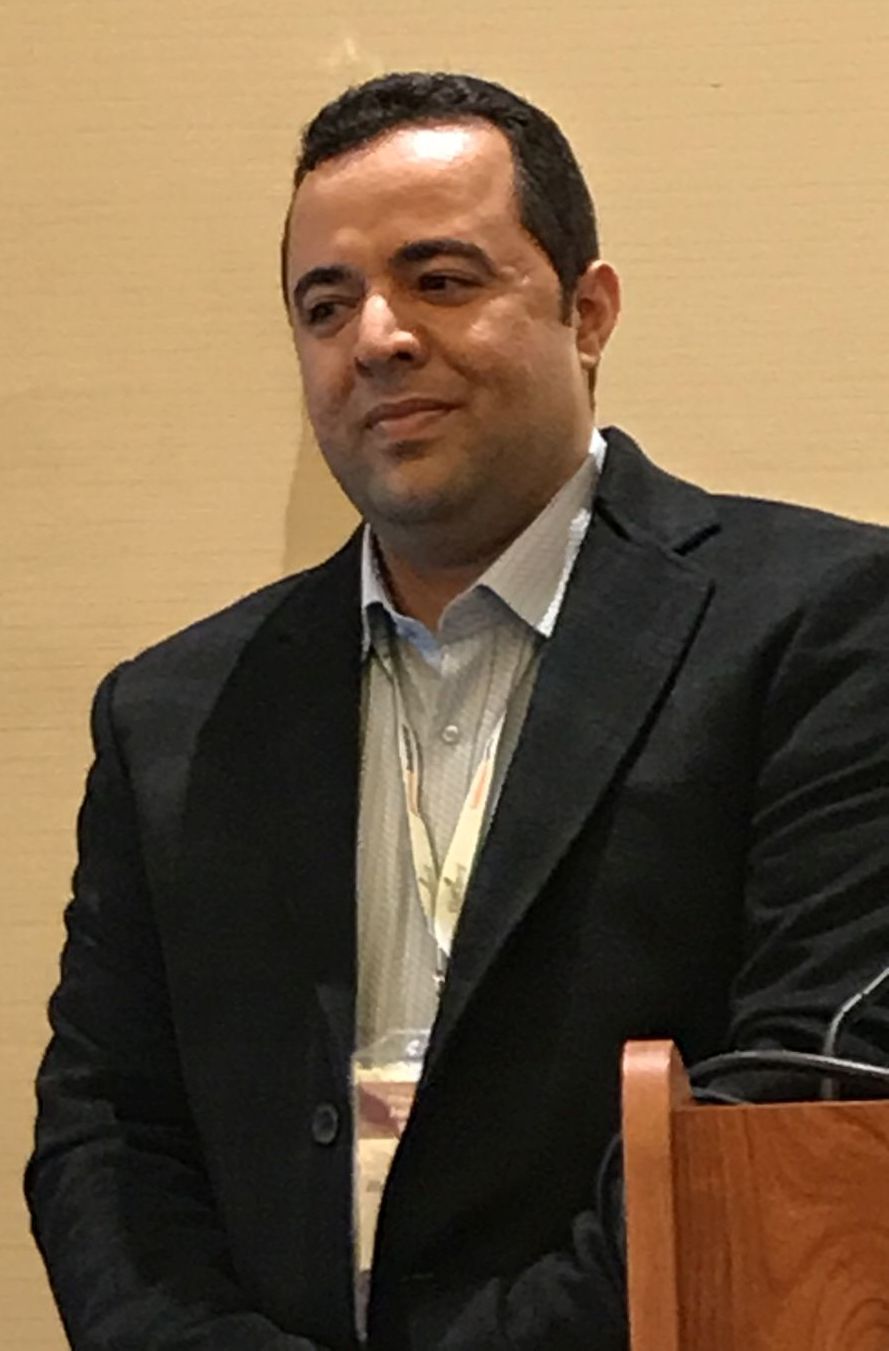User login
NEW YORK – When paraganglionic lesions are compared with isolated basal ganglionic lesions in children, important differences in clinical manifestations were identified, according to imaging-based findings presented at the International Conference on Parkinson’s Disease and Movement Disorders.
“The percentage of children with impaired cognitive function, motor weakness, and disturbed level of consciousness were all significantly higher among the paraganglionic group,” reported Hamada I. Zehry, MD, of Al-Azhar University, Cairo, Egypt.
Conversely, “the incidence of abnormal movements and rigidity were significantly higher among the group with basal ganglion lesions alone,” he said.
The findings were based on comparisons made after MRI imaging differentiated the 23 children with basal ganglionic lesions alone (IG) from 11 children with paraganglionic lesions (PG). About half of the PG group also had lesions involving the basal ganglion as well. All patients were 18 years of age or younger. The mean ages were 9 years in the IG group and 5.7 years in the PG group (P less than .04). Both groups contained approximately 55% males.
Both the IG and PG groups were stratified by ischemic, infectious, metabolic, and toxic etiologies. For the IG relative to the PG group, the ischemic (34.8% vs. 36.4%), infectious (26.1% vs. 36.4%), and metabolic (30.4% vs. 27.2%) etiologies had a relatively similar distribution. However, there was no patient in the PG group with a toxic etiology versus 8.7% (P = .003) in the IG group.
Neurologic symptoms by lesion site differed. Cognitive dysfunction (55% vs. 26%), seizures (64% vs. 43%), muscle weakness (45% vs. 30%), and changes in level of consciousness (82% vs. 22%) were all more common in the PG than the IG group according to Dr. Zehry. However, abnormal movements (30% vs. 9%) and rigidity (17% vs. 0%) were more common in the IG group.
These differences were all significant by conventional statistical analysis (P less than .05), according to Dr. Zehry, although he did not provide the specific P values for each of the comparisons.
There were also differences in the frequency of neurologic symptoms within groups when stratified by etiology. Of the biggest differences in the IG group, cognitive dysfunction was observed in 57% of those with a metabolic etiology but only 17% of those with an infectious etiology and 13% of those with an ischemic etiology. None of those with a toxic etiology had cognitive dysfunction.
In the PG group, the rates of cognitive dysfunction were 25%, 50%, and 100% for the ischemic, infectious, and metabolic etiologies, respectively. Changed levels of consciousness were observed in 75%, 100%, and 67% of these etiologies, respectively, in the PG group, but in only 13%, 33%, and 0%, respectively, in the IG group. In those with a toxic etiology in the IG group, a changed level of consciousness was observed in 100%.
Laboratory findings also were compared between groups and between etiologies within groups. It is notable that liver dysfunction and cytopenias were confined to those with metabolic infectious etiologies in both the IG and PG patients. However, Dr. Zehry suggested that the significance of these and other differences in laboratory findings deserve confirmation and further study in a larger study.
In this series, which excluded patients with a history of trauma or tumors, Dr. Zehry emphasized that bilateral lesions were commonly found in both groups. Overall, he cautioned that distinguishing IG and PG “is not straightforward.” In addition to MRI, he suggested additional imaging tools – such as MR angiography, MR venography, and CT scans – might be useful for evaluating children suspected of pathology in the basal ganglion.
Because there is often bilateral involvement, “the careful assessment of imaging abnormalities occurring simultaneously with bilateral ganglionic injury is recommended,” he said. He added that the diagnosis can also be facilitated by correlating imaging features with clinical and laboratory data.”
NEW YORK – When paraganglionic lesions are compared with isolated basal ganglionic lesions in children, important differences in clinical manifestations were identified, according to imaging-based findings presented at the International Conference on Parkinson’s Disease and Movement Disorders.
“The percentage of children with impaired cognitive function, motor weakness, and disturbed level of consciousness were all significantly higher among the paraganglionic group,” reported Hamada I. Zehry, MD, of Al-Azhar University, Cairo, Egypt.
Conversely, “the incidence of abnormal movements and rigidity were significantly higher among the group with basal ganglion lesions alone,” he said.
The findings were based on comparisons made after MRI imaging differentiated the 23 children with basal ganglionic lesions alone (IG) from 11 children with paraganglionic lesions (PG). About half of the PG group also had lesions involving the basal ganglion as well. All patients were 18 years of age or younger. The mean ages were 9 years in the IG group and 5.7 years in the PG group (P less than .04). Both groups contained approximately 55% males.
Both the IG and PG groups were stratified by ischemic, infectious, metabolic, and toxic etiologies. For the IG relative to the PG group, the ischemic (34.8% vs. 36.4%), infectious (26.1% vs. 36.4%), and metabolic (30.4% vs. 27.2%) etiologies had a relatively similar distribution. However, there was no patient in the PG group with a toxic etiology versus 8.7% (P = .003) in the IG group.
Neurologic symptoms by lesion site differed. Cognitive dysfunction (55% vs. 26%), seizures (64% vs. 43%), muscle weakness (45% vs. 30%), and changes in level of consciousness (82% vs. 22%) were all more common in the PG than the IG group according to Dr. Zehry. However, abnormal movements (30% vs. 9%) and rigidity (17% vs. 0%) were more common in the IG group.
These differences were all significant by conventional statistical analysis (P less than .05), according to Dr. Zehry, although he did not provide the specific P values for each of the comparisons.
There were also differences in the frequency of neurologic symptoms within groups when stratified by etiology. Of the biggest differences in the IG group, cognitive dysfunction was observed in 57% of those with a metabolic etiology but only 17% of those with an infectious etiology and 13% of those with an ischemic etiology. None of those with a toxic etiology had cognitive dysfunction.
In the PG group, the rates of cognitive dysfunction were 25%, 50%, and 100% for the ischemic, infectious, and metabolic etiologies, respectively. Changed levels of consciousness were observed in 75%, 100%, and 67% of these etiologies, respectively, in the PG group, but in only 13%, 33%, and 0%, respectively, in the IG group. In those with a toxic etiology in the IG group, a changed level of consciousness was observed in 100%.
Laboratory findings also were compared between groups and between etiologies within groups. It is notable that liver dysfunction and cytopenias were confined to those with metabolic infectious etiologies in both the IG and PG patients. However, Dr. Zehry suggested that the significance of these and other differences in laboratory findings deserve confirmation and further study in a larger study.
In this series, which excluded patients with a history of trauma or tumors, Dr. Zehry emphasized that bilateral lesions were commonly found in both groups. Overall, he cautioned that distinguishing IG and PG “is not straightforward.” In addition to MRI, he suggested additional imaging tools – such as MR angiography, MR venography, and CT scans – might be useful for evaluating children suspected of pathology in the basal ganglion.
Because there is often bilateral involvement, “the careful assessment of imaging abnormalities occurring simultaneously with bilateral ganglionic injury is recommended,” he said. He added that the diagnosis can also be facilitated by correlating imaging features with clinical and laboratory data.”
NEW YORK – When paraganglionic lesions are compared with isolated basal ganglionic lesions in children, important differences in clinical manifestations were identified, according to imaging-based findings presented at the International Conference on Parkinson’s Disease and Movement Disorders.
“The percentage of children with impaired cognitive function, motor weakness, and disturbed level of consciousness were all significantly higher among the paraganglionic group,” reported Hamada I. Zehry, MD, of Al-Azhar University, Cairo, Egypt.
Conversely, “the incidence of abnormal movements and rigidity were significantly higher among the group with basal ganglion lesions alone,” he said.
The findings were based on comparisons made after MRI imaging differentiated the 23 children with basal ganglionic lesions alone (IG) from 11 children with paraganglionic lesions (PG). About half of the PG group also had lesions involving the basal ganglion as well. All patients were 18 years of age or younger. The mean ages were 9 years in the IG group and 5.7 years in the PG group (P less than .04). Both groups contained approximately 55% males.
Both the IG and PG groups were stratified by ischemic, infectious, metabolic, and toxic etiologies. For the IG relative to the PG group, the ischemic (34.8% vs. 36.4%), infectious (26.1% vs. 36.4%), and metabolic (30.4% vs. 27.2%) etiologies had a relatively similar distribution. However, there was no patient in the PG group with a toxic etiology versus 8.7% (P = .003) in the IG group.
Neurologic symptoms by lesion site differed. Cognitive dysfunction (55% vs. 26%), seizures (64% vs. 43%), muscle weakness (45% vs. 30%), and changes in level of consciousness (82% vs. 22%) were all more common in the PG than the IG group according to Dr. Zehry. However, abnormal movements (30% vs. 9%) and rigidity (17% vs. 0%) were more common in the IG group.
These differences were all significant by conventional statistical analysis (P less than .05), according to Dr. Zehry, although he did not provide the specific P values for each of the comparisons.
There were also differences in the frequency of neurologic symptoms within groups when stratified by etiology. Of the biggest differences in the IG group, cognitive dysfunction was observed in 57% of those with a metabolic etiology but only 17% of those with an infectious etiology and 13% of those with an ischemic etiology. None of those with a toxic etiology had cognitive dysfunction.
In the PG group, the rates of cognitive dysfunction were 25%, 50%, and 100% for the ischemic, infectious, and metabolic etiologies, respectively. Changed levels of consciousness were observed in 75%, 100%, and 67% of these etiologies, respectively, in the PG group, but in only 13%, 33%, and 0%, respectively, in the IG group. In those with a toxic etiology in the IG group, a changed level of consciousness was observed in 100%.
Laboratory findings also were compared between groups and between etiologies within groups. It is notable that liver dysfunction and cytopenias were confined to those with metabolic infectious etiologies in both the IG and PG patients. However, Dr. Zehry suggested that the significance of these and other differences in laboratory findings deserve confirmation and further study in a larger study.
In this series, which excluded patients with a history of trauma or tumors, Dr. Zehry emphasized that bilateral lesions were commonly found in both groups. Overall, he cautioned that distinguishing IG and PG “is not straightforward.” In addition to MRI, he suggested additional imaging tools – such as MR angiography, MR venography, and CT scans – might be useful for evaluating children suspected of pathology in the basal ganglion.
Because there is often bilateral involvement, “the careful assessment of imaging abnormalities occurring simultaneously with bilateral ganglionic injury is recommended,” he said. He added that the diagnosis can also be facilitated by correlating imaging features with clinical and laboratory data.”
REPORTING FROM ICPDMD 2018
Key clinical point: In children with basal ganglion and paraganglion lesions, injury site on imaging yields clinical distinctions.
Major finding: Relative to isolated lesions, paraganglion lesions produce more neuropathy such as cognitive dysfunction (57% vs. 26%; P less than .05)
Study details: Cross-sectional observational study.
Disclosures: Dr. Zehry reports no financial relationships relevant to this study.

